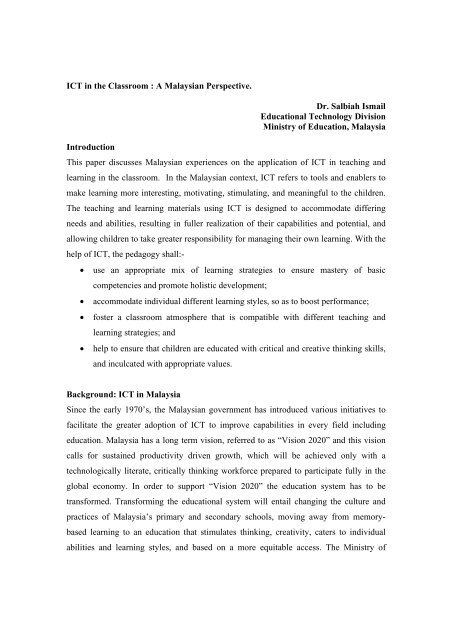ICT in the Classroom : A Malaysian Perspective. Dr. Salbiah Ismail ...
ICT in the Classroom : A Malaysian Perspective. Dr. Salbiah Ismail ...
ICT in the Classroom : A Malaysian Perspective. Dr. Salbiah Ismail ...
- No tags were found...
You also want an ePaper? Increase the reach of your titles
YUMPU automatically turns print PDFs into web optimized ePapers that Google loves.
<strong>ICT</strong> <strong>in</strong> <strong>the</strong> <strong>Classroom</strong> : A <strong>Malaysian</strong> <strong>Perspective</strong>.<strong>Dr</strong>. <strong>Salbiah</strong> <strong>Ismail</strong>Educational Technology DivisionM<strong>in</strong>istry of Education, MalaysiaIntroductionThis paper discusses <strong>Malaysian</strong> experiences on <strong>the</strong> application of <strong>ICT</strong> <strong>in</strong> teach<strong>in</strong>g andlearn<strong>in</strong>g <strong>in</strong> <strong>the</strong> classroom. In <strong>the</strong> <strong>Malaysian</strong> context, <strong>ICT</strong> refers to tools and enablers tomake learn<strong>in</strong>g more <strong>in</strong>terest<strong>in</strong>g, motivat<strong>in</strong>g, stimulat<strong>in</strong>g, and mean<strong>in</strong>gful to <strong>the</strong> children.The teach<strong>in</strong>g and learn<strong>in</strong>g materials us<strong>in</strong>g <strong>ICT</strong> is designed to accommodate differ<strong>in</strong>gneeds and abilities, result<strong>in</strong>g <strong>in</strong> fuller realization of <strong>the</strong>ir capabilities and potential, andallow<strong>in</strong>g children to take greater responsibility for manag<strong>in</strong>g <strong>the</strong>ir own learn<strong>in</strong>g. With <strong>the</strong>help of <strong>ICT</strong>, <strong>the</strong> pedagogy shall:-• use an appropriate mix of learn<strong>in</strong>g strategies to ensure mastery of basiccompetencies and promote holistic development;• accommodate <strong>in</strong>dividual different learn<strong>in</strong>g styles, so as to boost performance;• foster a classroom atmosphere that is compatible with different teach<strong>in</strong>g andlearn<strong>in</strong>g strategies; and• help to ensure that children are educated with critical and creative th<strong>in</strong>k<strong>in</strong>g skills,and <strong>in</strong>culcated with appropriate values.Background: <strong>ICT</strong> <strong>in</strong> MalaysiaS<strong>in</strong>ce <strong>the</strong> early 1970’s, <strong>the</strong> <strong>Malaysian</strong> government has <strong>in</strong>troduced various <strong>in</strong>itiatives tofacilitate <strong>the</strong> greater adoption of <strong>ICT</strong> to improve capabilities <strong>in</strong> every field <strong>in</strong>clud<strong>in</strong>geducation. Malaysia has a long term vision, referred to as “Vision 2020” and this visioncalls for susta<strong>in</strong>ed productivity driven growth, which will be achieved only with atechnologically literate, critically th<strong>in</strong>k<strong>in</strong>g workforce prepared to participate fully <strong>in</strong> <strong>the</strong>global economy. In order to support “Vision 2020” <strong>the</strong> education system has to betransformed. Transform<strong>in</strong>g <strong>the</strong> educational system will entail chang<strong>in</strong>g <strong>the</strong> culture andpractices of Malaysia’s primary and secondary schools, mov<strong>in</strong>g away from memorybasedlearn<strong>in</strong>g to an education that stimulates th<strong>in</strong>k<strong>in</strong>g, creativity, caters to <strong>in</strong>dividualabilities and learn<strong>in</strong>g styles, and based on a more equitable access. The M<strong>in</strong>istry of
Education sees <strong>ICT</strong> as a means, not an end to itself. Technology is not seen as a“vitam<strong>in</strong>” whose mere presence <strong>in</strong> schools can catalyze better educational outcomes. Theconcept of <strong>ICT</strong> <strong>in</strong> education, as seen by <strong>the</strong> M<strong>in</strong>istry of Education, <strong>in</strong>cludes systems thatenable <strong>in</strong>formation ga<strong>the</strong>r<strong>in</strong>g, management, manipulation, access, and communication <strong>in</strong>various forms. The role and function of <strong>ICT</strong> <strong>in</strong> <strong>the</strong> classroom is seen as a teach<strong>in</strong>g andlearn<strong>in</strong>g tool, as well as a part of a subject and a subject by itself.Examples of <strong>the</strong> use of <strong>ICT</strong> <strong>in</strong> <strong>the</strong> classrooma. The <strong>Malaysian</strong> SMART schoolThe SMART school is a government <strong>in</strong>itiative and one of seven flagshipapplications that are a part of Malaysia’s Multimedia Super Corridor project. Thepilot project was launched <strong>in</strong> 1997 and ended at <strong>the</strong> end of 2002. By <strong>the</strong> year 2003,<strong>the</strong>re are 87 smart schools <strong>in</strong> Malaysia. However, this number will be <strong>in</strong>creased <strong>in</strong><strong>the</strong> Phase 1 “roll out plan” which will be tak<strong>in</strong>g place <strong>in</strong> <strong>the</strong> year 2004 and 2005.In <strong>the</strong> “roll out plan” ano<strong>the</strong>r 300 primary and secondary schools will be <strong>in</strong>cludedas SMART schools. As for <strong>ICT</strong> <strong>in</strong> <strong>the</strong> classroom, Smart School IntegratedSolution <strong>in</strong>volves <strong>the</strong> follow<strong>in</strong>g components.• Browser-based Teach<strong>in</strong>g and Learn<strong>in</strong>g Materials for four subjects, BahasaMelayu, English Language, Science and Ma<strong>the</strong>matics. By June 2003,<strong>the</strong>re are 1494 titles of courseware have been produced for <strong>the</strong> usage ofschools. In <strong>the</strong> “roll out plan” more courseware will be developed,especially for science subjects such as Physics, Biology, Chemistry andAdditional Ma<strong>the</strong>matics.• A computerized SMART school management system which <strong>in</strong>cludesfunction “Collaboration” whereby students can exchange ideas regard<strong>in</strong>g<strong>the</strong>ir projects with o<strong>the</strong>r students with<strong>in</strong> <strong>the</strong>ir own school as well as <strong>in</strong>terschoolswith expert supervision from teachers.• Some schools have facilities to carry out video conferenc<strong>in</strong>g activitieswith o<strong>the</strong>r schools with<strong>in</strong> and outside of Malaysia.
. As a subject<strong>ICT</strong> as a subject refers to <strong>the</strong> <strong>in</strong>troduction of subjects such as “InformationTechnology” and “Computerization” which are offered to students at <strong>the</strong> age of16 and 17 years old. <strong>ICT</strong> as a part of a subject refers to <strong>the</strong> <strong>in</strong>tensive use ofsoftware <strong>in</strong> subjects such as ‘Invention’, Technical <strong>Dr</strong>aw<strong>in</strong>g and Eng<strong>in</strong>eer<strong>in</strong>gTechnology. In most schools, students are <strong>in</strong>troduced to subject of “LiteracyComputer” which will equip <strong>the</strong>m with <strong>the</strong> basic skills of us<strong>in</strong>g <strong>the</strong> computer.c. Interactive CD ROMThese are ‘Stand Alone’ courseware developed by <strong>the</strong> Educational TechnologyDivision, M<strong>in</strong>istry of Education Malaysia. These courseware covers all <strong>the</strong>subjects offered to primary as well as secondary schools. It has been used by <strong>the</strong>teachers as one of <strong>the</strong> most effective tools to enhance teach<strong>in</strong>g and learn<strong>in</strong>gprocesses.d. Internet usageStudents are encouraged to extract <strong>in</strong>formation from various sources <strong>in</strong>clud<strong>in</strong>g <strong>the</strong>usage of <strong>in</strong>ternet and websites. The websites provided are l<strong>in</strong>ks to help teachersand students access educational <strong>in</strong>formation readily.e. Universal Services ProjectThis project is carried out by <strong>the</strong> M<strong>in</strong>istry of Energy, Communication andMultimedia and M<strong>in</strong>istry of Education Malaysia to provide <strong>ICT</strong> facilities to <strong>the</strong>schools and community <strong>in</strong> <strong>the</strong> “Infrastructure Deficit Areas” <strong>in</strong> Malaysia. Thefocus of this project is to bridge <strong>the</strong> digital divide and gap <strong>in</strong> Malaysia.Challenges• Infrastructure : physical and basic (electricity)• Connectivity• Technical Support• Stability of <strong>the</strong> system• Teachers skill and aptitude• Focus on exam<strong>in</strong>ation (public)

















